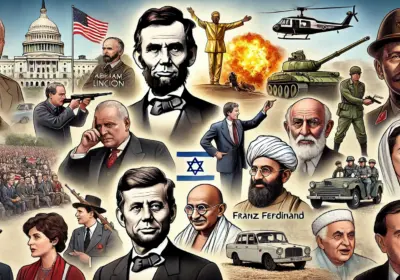Political figures play crucial roles on the global stage and guide societies through their policies and decisions. Therefore, their security has always been a top priority for governments and organizations worldwide. Assassination attempts on political figures have occurred throughout history, leaving deep impacts on societies and sometimes altering the course of history. In this article, we will discuss the security of political figures, the challenges they face, and some significant historical assassination attempts.

The Security of Political Figures
The security of political figures is a complex and multifaceted operation involving various state institutions, private security firms, and advanced technologies. These security measures can vary depending on the figure’s position, the perceived level of threat, and the political climate. Here are some common elements involved in the security of political figures:
- Personal Protection Team: A dedicated team of highly trained bodyguards who provide constant protection to the political figure. These individuals are often selected based on their skills, experience, and ability to remain vigilant under pressure.
- Security Technologies: The use of advanced technology is crucial in ensuring the safety of political figures. This includes metal detectors, surveillance cameras, access control systems, and biometric authentication devices. These technologies help in early detection and prevention of potential threats.
- Armored Vehicles: Political figures often travel in specially designed armored vehicles that provide protection against various types of attacks, including firearms and explosives. These vehicles are equipped with bulletproof glass, reinforced body panels, and secure communication systems.
- Residence and Office Security: The homes and offices of political figures are fortified with multiple layers of security, including perimeter fencing, surveillance systems, and secure rooms. These measures ensure that they are safe even in the event of a direct attack.
- Event Security: When political figures attend public events, extensive planning and coordination are required to ensure their safety. This includes securing the venue, screening attendees, and having a rapid response team on standby.
- Training and Preparation: Regular training and emergency preparedness drills are conducted for political figures and their close associates. This training covers various scenarios, including evacuation procedures, defensive tactics, and how to respond in case of an attack.
Challenges in Protecting Political Figures
Protecting political figures comes with numerous challenges. The nature of their work requires them to be in the public eye, making them vulnerable to attacks. Here are some of the main challenges faced in their protection:
- Public Exposure: Political figures often attend public events, rallies, and meetings, where large crowds are present. This exposure increases the risk of an attack, making it challenging to ensure their safety.
- Unpredictable Threats: Threats to political figures can come from various sources, including individuals, terrorist groups, and political adversaries. The unpredictable nature of these threats requires constant vigilance and adaptability.
- Balancing Security and Accessibility: Political figures need to be accessible to the public to perform their duties effectively. Striking a balance between maintaining high security and allowing public interaction is a delicate task.
- Technological Advancements: While technology aids in security, it also provides new tools for attackers. Keeping up with the latest technological advancements and potential threats is essential for effective protection.
Significant Historical Assassination Attempts
Throughout history, many political figures have been targets of assassination attempts, some of which have been successful, leaving lasting impacts on their nations and the world. Here are some notable examples:
- Abraham Lincoln (1865): The 16th President of the United States, Abraham Lincoln, was assassinated by John Wilkes Booth while attending a play at Ford’s Theatre in Washington, D.C. This tragic event occurred just days after the end of the American Civil War, significantly affecting the nation’s reconstruction period.
- John F. Kennedy (1963): The 35th President of the United States, John F. Kennedy, was assassinated in Dallas, Texas, while riding in a motorcade. Lee Harvey Oswald was identified as the shooter. Kennedy’s assassination left the nation in shock and led to numerous conspiracy theories and investigations.
- Franz Ferdinand (1914): Archduke Franz Ferdinand of Austria and his wife were assassinated by Gavrilo Princip in Sarajevo. This event is widely regarded as the catalyst for World War I, as it set off a chain reaction of alliances and conflicts.
- Mahatma Gandhi (1948): Indian independence leader Mahatma Gandhi was assassinated by Nathuram Godse in New Delhi. Gandhi’s death was a significant blow to the Indian independence movement and the nation as a whole, as he was a symbol of nonviolent resistance and unity.
- Yitzhak Rabin (1995): Israeli Prime Minister Yitzhak Rabin was assassinated by Yigal Amir, an Israeli extremist opposed to Rabin’s peace efforts with the Palestinians. Rabin’s assassination was a major setback for the peace process in the Middle East.
- Benazir Bhutto (2007): Former Prime Minister of Pakistan, Benazir Bhutto, was assassinated in a combined shooting and bombing attack during a political rally in Rawalpindi. Her death marked a significant moment in Pakistan’s turbulent political history.
Conclusion
The security of political figures is crucial for maintaining societal stability and ensuring the continuity of governance. Historical assassination attempts highlight the critical importance of robust security measures and constant vigilance. As technology and methods advance, the protection of these key individuals continues to evolve, ensuring they can fulfill their duties without fear of harm. By understanding the complexities and challenges of protecting political figures, we can appreciate the efforts made to safeguard those who shape our world.









